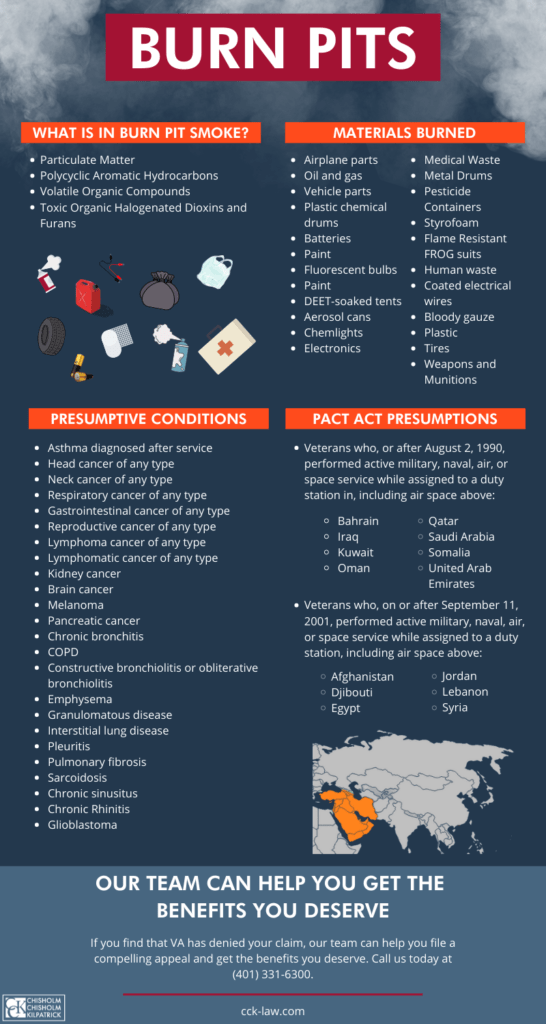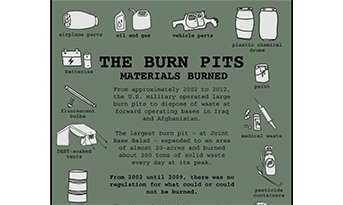VA Disability for Constrictive Bronchiolitis

CCK Law: Our Vital Role in Veterans Law
What is Constructive Bronchiolitis?
Constrictive Bronchiolitis (CB), also called obliterative bronchiolitis, is a fibrotic respiratory disease characterized by the inflammation of small airways. Those who have constructive bronchiolitis often experience a persistent cough and dyspnea. Many veterans have developed constrictive bronchiolitis as a result of their time in service.
The condition is very difficult to diagnose and extremely uncommon. Patients with constrictive bronchiolitis can have shortness of breath when they exert themselves, but also have normal chest X-rays and pulmonary functioning test results.
Constrictive bronchiolitis is often diagnosed as chronic pulmonary obstructive disease (COPD). To correctly diagnose CB, patients must undergo a surgical lung biopsy, an invasive procedure that can confirm their diagnosis. Since constrictive bronchiolitis, or obliterative bronchiolitis, is uncommon and difficult to diagnose, VA frequently rates veterans with this condition incorrectly.
What Can Cause Constrictive Bronchiolitis in Veterans?
One of the generally accepted causes of constrictive bronchiolitis in veterans, as well as the civilian population, includes inhalation of toxic fumes. For veterans of Operation Enduring Freedom (OEF) and Operation Iraqi Freedom (OIF), these fumes can include those emitted from open air burn pits and sulfur fires. As such, many veterans who served in Iraq suffer from constrictive bronchiolitis.
In a 2011 study published by the New England Journal of Medicine, researchers investigated the prevalence of constructive bronchiolitis among veterans. The study found that of 49 veterans who underwent a lung biopsy, 38 of them were also diagnosed with constrictive bronchiolitis. This means that many veterans who served in OEF and OIF who have lung conditions likely have constrictive bronchiolitis.
Burn Pits
Burn pits were used as a means of waste disposal in Iraq, Afghanistan and Djibouti after September 11, 2001. Military personnel burned hazardous materials such as human and medical waste, ammunition, aluminum and plastics, and fuel. One of the most well-known of these pits was located at Joint Base Balad and spanned more than 10 acres.

Particulate Matter
Burn pits also emitted particulate matter into the air surrounding the areas where substances where burned. Particulate matter is a mixture of very small particles and liquid droplets that can be harmful when inhaled or ingested.
Service members in Southwest Asia could have been exposed to particulate matter, leading to respiratory and cardiopulmonary health effects. Long-term exposure to ultrafine particulate matter has been associated with small airway diseases such as constrictive bronchiolitis. In addition to the particulate matter emitted from burn pits, service members were also exposed to dust and sandstorms in Iraq and Afghanistan, another significant source of particulate matter.
Sulfur Mines
Another known military cause of constrictive bronchiolitis is sulfur dioxide and hydrogen sulfide gases. On June 24, 2003, Mishraq State Sulfur Mine Plant in Northern Iraq caught fire and burned for approximately three weeks. The toxic fumes emitted from the fire impacted many troops who were located near the plant. Both sulfur dioxide and hydrogen sulfide gases can produce coughing, and irritation of the eyes, nose, and throat. At high levels, sulfur dioxide can cause significant airway obstruction.
What is Training Letter 10-03?
In general, training letters are used by VA to instruct raters and those who work on veterans’ claims about specific issues. Training Letter 10-03 was published April 26, 2010. It was intended to advise VA employees how to approach and adjudicate claims related to environmental hazards in Iraq, Afghanistan, and other military installations, such as claims for service connection for constrictive bronchiolitis.
The Training Letter acknowledges that constrictive bronchiolitis is difficult to rate for VA disability purposes. VA uses pulmonary function tests to assess the severity of conditions such as Asthma and COPD for rating purposes. However, those with constrictive bronchiolitis can often have normal pulmonary function test, making it difficult for VA personnel to apply the correct rating.
Establishing Service Connection for Constrictive Bronchiolitis
The Training Letter notes that veteran’s “lay statement of exposure to the [Mishraq] sulfur fire is sufficient if his or her service records shows service in Iraq at Mosul Airfield or Qayyarah Airfield West” during the four-week period that the sulfur fire burned.
If you are not sure if you were exposed to the sulfur fire, you can still file a claim. In the Training Letter, VA personnel are instructed to actively review claims for potential exposures. This means they should always consider whether a veteran was potentially exposed to environmental hazards during their service. They do this by looking at where veterans were stationed as well as consulting their service records. However, if you think you were exposed to the sulfur fire or burn pits, it is helpful to include lay statements with your claim detailing your exposure.
Additionally, the Training Letter instructs VA personnel to request Compensation and Pension Examinations (C&P) for environmental-hazard claims for veterans who have:
- A current diagnosed disability or persistent or recurrent symptoms of disability;
- Evidence of exposure to an in-service exposure event; and
- Evidence that the claimed condition may be associated with the in-service exposure.
Presumptive Service Connection for Constrictive Bronchiolitis
VA offers presumptive service connection to veterans with certain conditions who served in qualifying timeframes and locations. Presumptive service connection removes the requirement that veterans provide a medical nexus linking their condition to their military service. Essentially, if a veteran meets certain eligibility requirements, VA will presume that their condition is connected to their military service.
In July 2022, the Honoring Our Promise to Address Comprehensive Toxics Act (PACT Act) of 2021 added 23 conditions to VA’s presumptive list for toxic exposure, including constrictive or obliterative bronchiolitis. Now, “covered veterans” who developed constrictive bronchiolitis at any point during or after military service can qualify for presumptive service connection.
A covered veteran is defined as the following:
- A veteran who, on or after August 2, 1990, performed active military, naval, air, or space service while assigned to a duty station in, including air space above:
- Bahrain
- Iraq
- Kuwait
- Oman
- Qatar
- Saudi Arabia
- Somalia
- United Arab Emirates
- A veteran who, on or after September 11, 2001, performed active military, naval, air, or space service, while assigned to a duty station, including the airspace above:
- Afghanistan
- Djibouti
- Egypt
- Jordan
- Lebanon
- Syria
Veterans who served in one of the above locations during a qualifying time period and who developed constrictive bronchiolitis can now more easily secure VA disability compensation for their condition.

VA Disability Ratings for Constrictive Bronchiolitis
Once you show that your constrictive bronchiolitis is related to your time in service, VA will rate the severity of your condition to compensate you appropriately.
As mentioned above, constrictive bronchiolitis can be very difficult to rate, and it does not have its own rating criteria. This means that VA’s list of conditions for rating does not include constrictive bronchiolitis, so it must be rated “analogous” to another condition.
The Training Letter instructs VA personnel to rate constrictive bronchiolitis as analogous to the rating codes 6600-6604. These rating codes include the criteria for bronchitis, bronchiectasis, asthma, emphysema, and COPD.
Diagnostic Code 6600 for Chronic Bronchitis
100%– The veteran has:
- FEV–1 less than 40 percent of predicted value, or; the ratio of Forced Expiratory Volume in one second to Forced Vital Capacity (FEV–1/FVC) less than 40 percent, OR
- Diffusion Capacity of the Lung for Carbon Monoxide by the Single Breath Method (DLCO (SB)) less than 40-percent predicted, OR
- Maximum exercise capacity less than 15 ml/kg/min oxygen consumption (with cardiac or respiratory limitation), OR
- Cor pulmonale (right heart failure), OR
- Right ventricular hypertrophy, or; pulmonary hypertension (shown by Echo or cardiac catheterization), OR
- Episode(s) of acute respiratory failure, OR
- Requires outpatient oxygen therapy 100 FEV–1 of 40- to 55-percent predicted, OR
60%– The veteran has:
- FEV–1/FVC of 40 to 55 percent, OR
- DLCO (SB) of 40- to 55-percent predicted, OR
- Maximum oxygen consumption of 15 to 20 ml/kg/min (with cardiorespiratory limit)
30%– The veteran has:
- FEV–1 of 56- to 70-percent predicted, or; FEV–1/FVC of 56 to 70 percent, or; DLCO (SB) 56- to 65-percent predicted
10%– The veteran has:
- FEV–1 of 71- to 80-percent predicted, or; FEV–1/FVC of 71 to 80 percent, or; DLCO (SB) 66- to 80-percent predicted
Diagnostic Code 6601 for Bronchiectasis
100%– The veteran has bronchiectasis with:
- Incapacitating episodes of infection of at least six weeks total duration per year
60%– The veteran has bronchiectasis with:
- Incapacitating episodes of infection of four to six weeks total duration per year, OR
- Near constant findings of cough with purulent sputum associated with anorexia, weight loss, and frank hemoptysis and requiring antibiotic usage almost continuously
30%– The veteran has bronchiectasis with:
- Incapacitating episodes of infection of two to four weeks total duration per year, OR
- Daily productive cough with sputum that is at times purulent or blood-tinged and that requires prolonged (lasting four to six weeks) antibiotic usage more than twice a year
10%– The veteran has bronchiectasis with:
- Intermittent productive cough with acute infection requiring a course of antibiotics at least twice a year
Diagnostic Code 6602 for Asthma
100%– The veteran has asthma with:
- FEV–1 less than 40-percent predicted, or; FEV–1/FVC less than 40 percent, OR
- More than one attack per week with episodes of respiratory failure, or; requires daily use of systemic (oral or parenteral) high dose corticosteroids or immuno-suppressive medications
60%– The veteran has asthma with:
- FEV–1 of 40- to 55-percent predicted, OR
- FEV–1/FVC of 40 to 55 percent, OR
- At least monthly visits to a physician for required care of exacerbations, OR
- Intermittent (at least three per year) courses of systemic (oral or parenteral) corticosteroids
30%– The veteran has asthma with:
- FEV–1 of 56- to 70-percent predicted, OR
- FEV–1/FVC of 56 to 70 percent, OR
- Daily inhalational or oral bronchodilator therapy, OR
- Inhalational anti-inflammatory medication
10%– The veteran has asthma with:
- FEV–1 of 71- to 80-percent predicted, OR
- FEV–1/FVC of 71 to 80 percent, OR
- Intermittent inhalational or oral bronchodilator therapy
NOTE: In the absence of clinical findings of asthma at the time of examination, a verified history of attacks needs to be in the record.

Diagnostic Code 6603 for Pulmonary Emphysema
100%– The veteran has pulmonary emphysema with:
- FEV–1 less than 40 percent of predicted value, OR
- The ratio of Forced Expiratory Volume in one second to Forced Vital Capacity (FEV–1/FVC) less than 40 percent, OR
- Diffusion Capacity of the Lung for Carbon Monoxide by the Single Breath Method (DLCO (SB)) less than 40-percent predicted, OR
- Maximum exercise capacity less than 15 ml/kg/min oxygen consumption (with cardiac or respiratory limitation), OR
- Cor pulmonale (right heart failure), OR
- Right ventricular hypertrophy, OR
- Pulmonary hypertension (shown by Echo or cardiac catheterization), OR
- Episode(s) of acute respiratory failure, OR
- outpatient oxygen therapy.
60%– The veteran has pulmonary emphysema with:
- FEV–1 of 40- to 55-percent predicted, OR
- FEV–1/FVC of 40 to 55 percent, OR
- DLCO (SB) of 40- to 55-percent predicted, OR
- Maximum oxygen consumption of 15 to 20 ml/kg/min (with cardiorespiratory limit)
30%– The veteran has pulmonary emphysema with:
- FEV–1 of 56- to 70-percent predicted, OR
- FEV–1/FVC of 56 to 70 percent, OR
- DLCO (SB) 56- to 65-percent predicted
10%– The veteran has pulmonary emphysema with:
- FEV–1 of 71- to 80-percent predicted, OR
- FEV–1/FVC of 71 to 80 percent, OR
- DLCO (SB) 66- to 80-percent predicted
Diagnostic Code 6604 for Chronic Obstructive Pulmonary Disease
100%– The veteran has COPD with:
- FEV–1 less than 40 percent of predicted value, OR
- The ratio of Forced Expiratory Volume in one second to Forced Vital Capacity (FEV–1/FVC) less than 40 percent, OR
- Diffusion Capacity of the Lung for Carbon Monoxide by the Single Breath Method (DLCO (SB)) less than 40-percent predicted, OR
- Maximum exercise capacity less than 15 ml/kg/min oxygen consumption (with cardiac or respiratory limitation), OR
- Cor pulmonale (right heart failure), OR
- Right ventricular hypertrophy, OR
- Pulmonary hypertension (shown by Echo or cardiac catheterization), OR
- Episode(s) of acute respiratory failure, OR
- Outpatient oxygen therapy
60%– The veteran has COPD with:
- FEV–1 of 40- to 55-percent predicted, OR
- FEV–1/FVC of 40 to 55 percent, OR
- DLCO (SB) of 40- to 55-percent predicted, OR
- Maximum oxygen consumption of 15 to 20 ml/kg/min (with cardiorespiratory limit)
30%– The veteran has COPD with:
- FEV–1 of 56- to 70-percent predicted, OR
- FEV–1/FVC of 56 to 70 percent, OR
- DLCO (SB) 56- to 65-percent predicted
10%– The veteran has COPD with:
- FEV–1 of 71- to 80-percent predicted, OR
- FEV–1/FVC of 71 to 80 percent, OR
- DLCO (SB) 66- to 80-percent predicted
TDIU Benefits for Constrictive Bronchiolitis
Training Letter 10-03 also instructs personnel to consider what is called “extraschedular ratings” when the veteran’s condition impacts their employment. Essentially, veterans who are prevented from working or maintaining substantial employment on account of their constrictive bronchiolitis may be eligible for total disability benefits based on individual unemployability (TDIU). TDIU is a monthly benefit that pays veterans at the 100 percent rate, regardless of their overall combined rating.
In order to be eligible for schedular TDIU, under 38 CFR § 4.16a, veterans will need to have:
- One service-connected condition rated at 60 percent or higher; or
- Two or more service-connected conditions, one of which is rated at least 40 percent disabling, with a combined disability rating of at least 70 percent.
Veterans with a rating for their constructive bronchiolitis, regardless of whether it is rated analogously, may be eligible for TDIU based on that rating. However, if veterans do not meet these criteria, they may qualify for individual unemployability on an extraschedular basis.
Extraschedular TDIU is rated under 38 CFR § 4.16b. When evaluating claims for extraschedular TDIU, VA personnel must investigate how constrictive bronchiolitis impacts the veteran’s ability to work and award compensation based on their loss in earning capacity.
Need Help Getting Your VA Disability Benefits for Constrictive Bronchiolitis?
Benefits for constrictive bronchiolitis are complicated by several factors, including the condition being rated analogously to other conditions and complicated rating criteria. As such, many veterans can grow frustrated when seeking VA disability benefits for their constrictive bronchiolitis. An accredited representative can help guide veterans through this process and answer any questions they may have.
If you have developed a severe respiratory condition due to your military service, the experienced team at Chisholm Chisholm & Kilpatrick may be able to help. Contact our office for a free consultation.
About the Author
Share this Post

